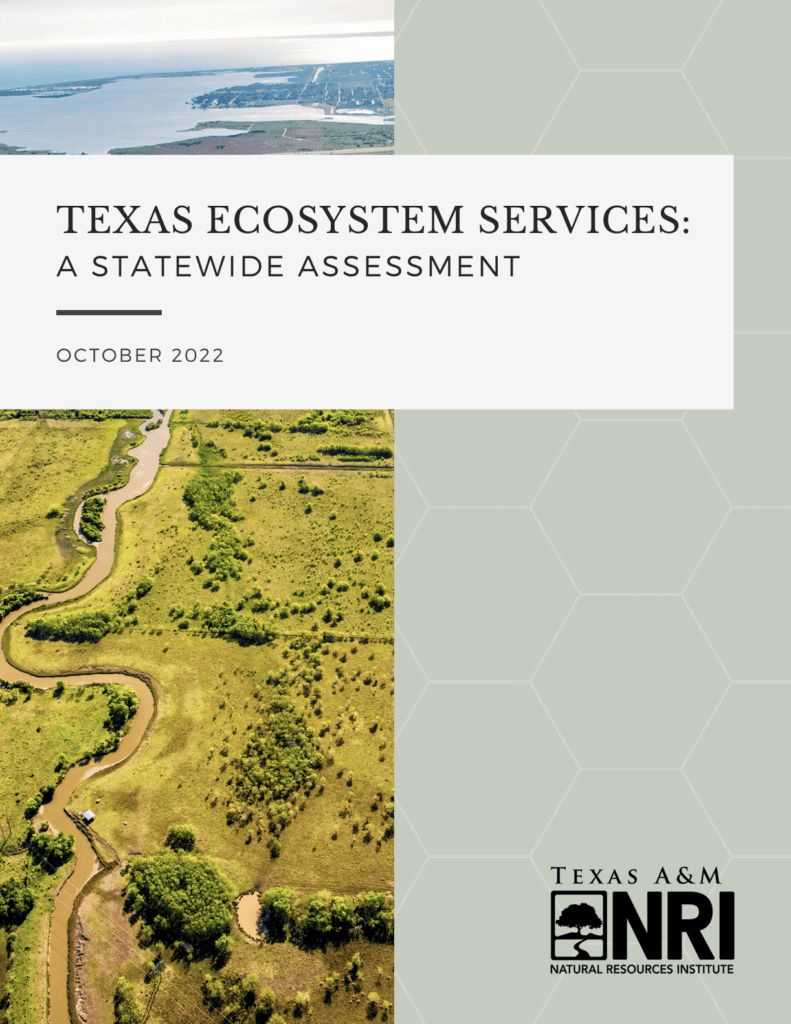New study estimates the value of working lands in Texas.
Every acre of working land in Texas contributes an average of $629 in ecosystem services annually, according to a new study, Texas Ecosystem Services: A Statewide Assessment.

The report, released by the Texas A&M Natural Resources Institute in conjunction with the Texas Agricultural Land Trust and the USDA Natural Resources Conservation Service in November 2022, is the state’s first attempt to better understand and estimate the value of its ecosystem services.
“The estimates give policymakers, municipalities, corporations, conservation organizations and land managers more insight into the full economic and ecological benefits Texas, and Texans, derive from these vital lands,” says Roel Lopez, Ph.D., director of the Texas A&M Natural Resources Institute and the university’s department head for rangeland, wildlife and fisheries management. “The report was created to help people understand the collective value of working land — and the consequences of losing it.”
Ecosystem services, the goods and benefits provided by the land back to the public, are also referred to as commodities of nature or natural capital. While the public has long recognized the benefits of food, fiber and timber, other benefits are often overlooked.
They include life-sustaining outputs such as climate regulation, air purification, pollination, abundant and clean water, wildlife habitat and flood control provided by healthy forests, rangelands and wetlands.
Historically, private landowners, through active management and conservation, have produced these goods and services at no cost to the public. As a result, these contributions largely went unrecognized and unvalued — until now.
“A confluence of factors, ranging from increasingly extreme weather to current and anticipated supply shortages spurred by ongoing population growth, as well as pressure by consumers and foreign governments for corporations to meet economic, social and governance mandates, has pushed the idea of ecosystem services markets to the forefront,” Lopez says. “As a result, ecosystem marketplaces are emerging quickly.”
One of the first steps in creating a market framework is establishing baseline value.
Lopez is quick to point out that the Texas Statewide Assessment is an initial effort designed to add to the emerging conversation about ecosystem services.
The Texas A&M Natural Resources Institute team identified 11 ecosystem services, which they valued using one of two estimates: market-based or willingness-to-pay.
To assign dollar values based on market-based estimates, the team used information from the Texas Comptroller of Public Accounts and the Texas Water Development Board, where appropriate. The willingness-to-pay estimates were derived from established federal field-scale or operation-level conservation programs through NRCS.
“Our findings can’t support a market yet, but they can form the basis for future refinements as we better understand ecosystem services and improve methods for measuring their benefits,” Lopez says. “To be clear, our goal wasn’t to establish a firm monetary value for these services, but to begin to highlight the values of land beyond the traditional.”
The Potential
While the markets for ecosystem services, led by carbon, are still emerging, their potential cannot be ignored.
“For the first time in my life, all eyes are on the land,” says Gary Price, a Texas & Southwestern Cattle Raisers Association director who ranches near Blooming Grove with his wife, Sue. “In my opinion, the potential for ecosystem services is huge.”
Price has been working with think tanks, non-profits, and corporations to help define and develop ecosystem service markets. From a landowner perspective, the potential benefits are threefold.
First, an operable free market could incentivize and pay for ecological services, such as carbon sequestration, clean water and biodiversity that landowners have historically provided to the public at no cost.
Eventually, ecosystem market proponents believe the services can be stacked to maximize the various land-based income streams. This is of particular value in today’s economy, where inflationary expenses increase operating costs.
“A lot of us know what to do and what we want to do for our land, but are limited by financial constraints,” Price says. “Ecosystem markets will not only provide financial returns, but incentivize everyone to embrace conservation practices that ultimately increase our individual productivity and benefit the public.”
Second, by highlighting the value to humanity, ecosystem services make the connection between working lands and life as we know it, and has the potential to inspire a widespread reconnection to nature and agriculture. And it creates an unprecedented opportunity for ranchers and farmers to tell their stories. With the added value of elevated platforms, cattle raisers can reach new audiences like never before.
“The public is interested in where their food comes from — and ranchers have a great story to tell,” says Price, who has been working closely with McDonald’s Corporation throughout the past four years on sustainability issues.
Consider the cow. She, influenced by the conscientious management of a committed land steward, is integral to the regeneration and long-term health of rangelands, which cover much of the U.S.
“If we didn’t have the cow, we’d be trying to invent her as a tool,” Price says.
Healthy rangelands are essential for carbon sequestration, protecting essential habitat for struggling wildlife populations and a host of other services.
And yet, the cow has been painted as an environmental menace by beef industry opponents, who have exploited the topics of methane production and overgrazing. The public, those disconnected from the land, can easily fall prey to these tactics and become industry opponents instead of consumers.
“If we don’t tell our story, someone else will,” Price says.
Needing to supply nearly 14,000 restaurants in the U.S. alone, McDonald’s is one of the largest purchasers of U.S. beef. The corporation has reached across the supply chain to work with the beef industry on long-term challenges to help ensure a more resilient beef supply.
As purveyors of burgers, industry opponents pummel the corporation just as they do ranchers. In addition, investors and consumers are demanding accountability, transparency and sustainability.
“The corporation’s success requires successful ranchers,” Price says.
Price challenges colleagues to imagine the impact of a partnership that combines ranching’s conservation story with the corporation’s marketing power.
“The people at McDonald’s are proud of their connection to beef, and I try to reinforce that connection by reminding them they have good reason to be proud,” Price says. “By selling hamburgers, they’re actually contributing to the health of rangelands, wildlife habitat and watersheds. Instead of destroying the planet, the corporation is actually benefiting it — one bite at a time.”
Third, if the value of ecosystem services and the role of the land that supports them is widely recognized, the marketplace could be used to help address conservation challenges, such as fragmentation, by helping shape development.
Texas loses 640 acres of working land per day, faster than any other state in the nation. Each time the state loses a piece of working land, the pressure increases on the remaining working lands to produce vital ecosystem services.
“Land disappears day after day, year after year,” Lopez says. “At what threshold does the landscape flip into subdivisions and suburbia and lose its ecological and economic productivity related to working lands?”
Unfortunately, most Texans don’t understand the consequences of the ongoing loss yet, which is where the report comes in.
For the first time ever, researchers can not only calculate the value of ecosystem services produced by land, but also the cost of losing working land in Texas.
Multiplying the $629 per-acre, per-year average by the daily loss of 640 acres for 365 days equals $146.9 million worth of lost ecosystem services every year.
“We’re paying a high price, one that’s climbing each year, as we convert more land to accommodate population growth in Texas,” Lopez says. “Those of us with a connection to the land know it because we live it. Now, it’s up to us to share that message way beyond the choir to benefit us all.”
Visit the Texas A&M Natural Resources Institute website, and click on research, to view a copy of the study.
Lorie A. Woodward is a freelance writer from Brenham.

